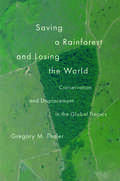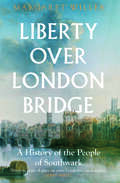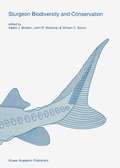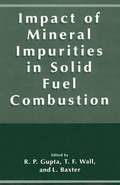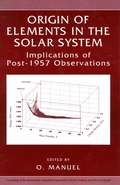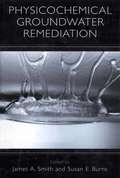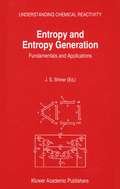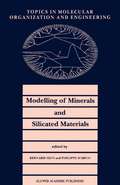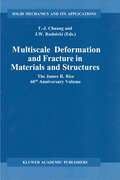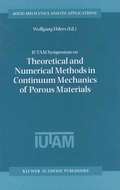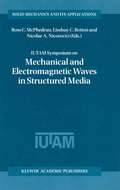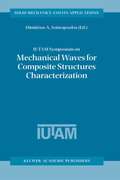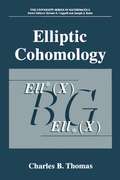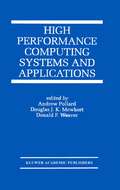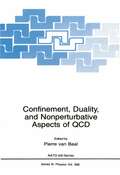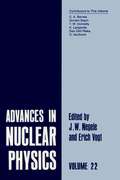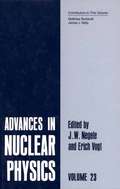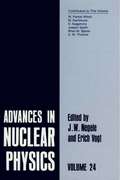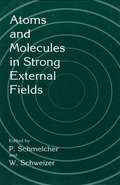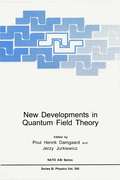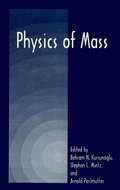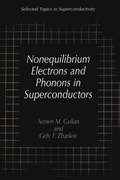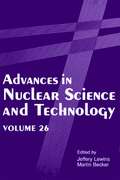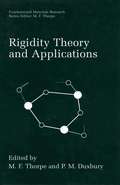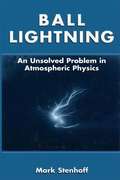- Table View
- List View
Saving a Rainforest and Losing the World: Conservation and Displacement in the Global Tropics (Yale Agrarian Studies Series)
by Gregory M. ThalerAn unflinching investigation of the false promises of land sparing, exposing how its illusory successes mask the failures of green capitalism For two decades, the concept of land sparing, the claim that agricultural intensification can spare land by preventing forest clearing for agricultural expansion, has dominated tropical forest conservation. Land sparing policies transform landscapes and livelihoods with the promise of reconciling agricultural development with environmental conservation. But that land sparing promise is false. Based on six years of research on agrarian frontiers in Indonesia, Brazil, and Bolivia, this book traces where and how land sparing becomes policy and charts the social and ecological effects of these political contests. Gregory M. Thaler explains why land sparing appears successful in some places but not in others and reveals that success as an illusion achieved by displacing deforestation to new frontiers. The failure of land sparing exposes a harsh truth behind assurances of green capitalism: capitalist development is ecocide.
Liberty over London Bridge: A History of the People of Southwark
by Margaret WillesThe first complete history of Southwark, London’s stubbornly independent community over the Thames Southwark’s fortunes have always been tied to those of the City of London across the river. But from its founding in Roman times through to flourishing in the medieval era, the Borough has always fiercely asserted its independence. A place of licence, largely free of the City’s jurisdiction, Southwark became a constant thorn in London’s side: an administrative anachronism, a commercial rival, and an asylum for undesirable industries and residents. In this remarkable history of London’s liberty beyond the bridge, Margaret Willes narrates the life and times of the people of Southwark, capturing the Borough’s anarchic spirit of revelry. Populated by a potent mix of talented immigrants, religious dissenters, theatrical folk, brewers, and sex workers, Southwark often escaped urban jurisdiction—giving it an atmosphere of danger, misrule, and artistic freedom. Tracing Southwark’s history from its Roman foundation to its present popularity as a place to visit, through Chaucer, to Shakespeare, and on to Dickens, Willes offers an indispensable exploration of the City’s unacknowledged mirror image.
Sturgeon biodiversity and conservation (Developments in Environmental Biology of Fishes #17)
by Vadim J. Birstein John R. Waldman William E. BemisSelected, reviewed and revised papers from the International Conference on Sturgeon Biodiversity and Conservation held at The American Museum of Natural History in New York on 28-30 July 1994
Impact of Mineral Impurities in Solid Fuel Combustion
by R. Gupta T. Wall L. BaxterThis book contains papers presented at the Engineering Foundation Conference on mineral matter in fuels held on November 2-7, 1997 in Kona, Hawaii. The conference is one of a continuing series that was initiated by the CEGB Mar- wood Engineering Laboratories in 1963. The conference was to be eventually organised by the Engineering Foundation as the need for multi-disciplinary work related to c- trolling ash effects in combustors became apparent. The conference covers both the science and the applications. The papers also present case histories, particularly for current fuel technologies, developments in advanced technologies for power generation and mathematical modelling of these processes. Developments since 1963 have been slow, but steady, due to the complexity of the chemical and physical processes involved. However, the research presented here displays great improvement in our understanding of the mechanisms by which mineral matter will influence fuel use. Steve Benson from EERC presented a review and current status of issues related to ash deposition in coal combustion and gasification. The application of new analytical tools, which have been detailed in the previous conferences, is presented. These include CCSEM, as well as new techniques for char- terising sintering of ash, such as TMA, image analysis, X-ray diffraction crystallography and thermal analysis. The new analytical techniques were extended to encompass widely differing fuels such as biomass. Ole H Larsen from ELSAM Denmark presented a review of these advanced techniques.
Origin of Elements in the Solar System: Implications of Post-1957 Observations
by Oliver K. ManuelBased on an American Chemical Society Symposium organized by Professors Glenn Seaborg and Oliver Manuel, this volume provides a comprehensive record of different views on this important subject at the end of the 20th century. They have assembled a blend of highly respected experimentalists and theorists from astronomy, geology, meteoritics, planetology and nuclear chemistry and physics to discuss the origin of elements in the solar system. The intent was to include all points of view and let history judge their validity.
Physicochemical Groundwater Remediation (Aids Prevention And Mental Health Ser.)
by James A. SmithAs we transition into the 21st century, it is apparent that this is an exciting time for environmental engineers and scientists studying remediation technologies. There has been a rapid development of new ways to clean-up polluted groundwater. Research activities of the past and next 10 years will have a dramatic impact on the quality of the subsurface environment for the next century. In 20, or even 10 years from now, our approach to subsurface remediation will probably be vastly different than it is today. Many of the emerging technologies presented in this book will form the basis of standard remediation practices of the future. Physicochemical Groundwater Remediation presents detailed information on multiple emerging technologies for the remediation of the contaminated subsurface environment. All of these technologies apply our knowledge of physical and chemical processes to clean up ground water and the unsaturated zone, and many (if not all) of these emerging technologies will help define standard practices in the future. These technologies include in situ sorptive and reactive treatment walls, surfactant-enhanced aquifer remediation, optimization analyses for remediation system design, chemical, electrochemical, and biochemical remediation processes, and monitored natural attenuation. You will learn how palladium catalyzes the dehalogenation of chlorinated solvents. You will find out how barometric pumping can naturally remove significant quantities of volatile organic pollutants from shallow ground water and the unsaturated zone. You can learn about mobilizing non-aqueous phase liquids (NAPLs) without risking significant downward migration of the NAPL. You can find out how processes such as electroosmosis and electromigration can be exploited for groundwater remediation purposes and how zero-valent iron and zeolite treatment walls can be used in situ to treat and control contaminant plume migration. Contributors to this book are experts in groundwater remediation processes, and they represent industry, consulting, academia, and government. If your work involves the clean up of contaminated soil and groundwater, this book is an essential reference to keep you up to date on the most promising new developments in remediation research.
Entropy and Entropy Generation: Fundamentals and Applications (Understanding Chemical Reactivity #18)
by J. S. ShinerEntropy and entropy generation play essential roles in our understanding of many diverse phenomena ranging from cosmology to biology. Their importance is manifest in areas of immediate practical interest such as the provision of global energy as well as in others of a more fundamental flavour such as the source of order and complexity in nature. They also form the basis of most modern formulations of both equilibrium and nonequilibrium thermodynamics. Today much progress is being made in our understanding of entropy and entropy generation in both fundamental aspects and application to concrete problems. The purpose of this volume is to present some of these recent and important results in a manner that not only appeals to the entropy specialist but also makes them accessible to the nonspecialist looking for an overview of the field. This book contains fourteen contributions by leading scientists in their fields. The content covers such topics as quantum thermodynamics, nonlinear processes, gravitational and irreversible thermodynamics, the thermodynamics of Taylor dispersion, higher order transport, the mesoscopic theory of liquid crystals, simulated annealing, information and biological aspects, global energy, photovoltaics, heat and mass transport and nonlinear electrochemical systems. Audience: This work will be of value to physicists, chemists, biologists and engineers interested in the theory and applications of entropy and its generation.
Modelling of Minerals and Silicated Materials (Topics in Molecular Organization and Engineering #15)
by B. Silvi P. D'ArcoThe modeling of minerals and silicated materials is a. difficult challenge faced by Solid StatePhysics, Quantum Chemistry and Molecular Dynamics communities. The difficulty of such a modeling is due to the wide diversity of elements, including heavy atoms,and types of bonding involved in such systems. Moreover, one has to consider infinite systems: either perfect cr- tals or glasses and melts. In the solid state a given chemical composition gives rise to numerous polymorphs, geometricallycloselyrelated. These polymorphs have very similar energies and related thermodynamical pr- erties which explain the complexity of their phase diagrams. The modeling of silicates and minerals covers a wide field of applications ranging from basic research to technology, from Solid State Physics to Earth and Planetary science. The use of modeling techniques yields information of different nature. In the case of chemical studies, we can mention inv- tigations on catalytic processes occurring on surfaces and in zeolite cages. These calculations find possible applications in chemical engineering, in particular in the oil industry.
Multiscale Deformation and Fracture in Materials and Structures: The James R. Rice 60th Anniversary Volume (Solid Mechanics and Its Applications #84)
by T. J. Chuang J. W. RudnickiModern Solid Mechanics considers phenomena at many levels, ranging from nano size at atomic scale through the continuum level at millimeter size to large structures at the tens of meter scale. The deformation and fracture behavior at these various scales are inextricably related to interdisciplinary methods derived from applied mathematics, physics, chemistry, and engineering mechanics. This book, in honor of James R. Rice, contains articles from his colleagues and former students that bring these sophisticated methods to bear on a wide range of problems. Articles discussing problems of deformation include topics of dislocation mechanics, second particle effects, plastic yield criterion on porous materials, hydrogen embrittlement, solid state sintering, nanophases at surfaces, adhesion and contact mechanics, diffuse instability in geomaterials, and percolation in metal deformation. In the fracture area, the topics include: elastic-plastic crack growth, dynamic fracture, stress intensity and J-integral analysis, stress-corrosion cracking, and fracture in single crystal, piezoelectric, composite and cementitious materials. The book will be a valuable resource for researchers in modern solid mechanics and can be used as reference or supplementary text in mechanical and civil engineering, applied mechanics, materials science, and engineering graduate courses on fracture mechanics, elasticity, plasticity, mechanics of materials or the application of solid mechanics to processing, and reliability of life predictions.
IUTAM Symposium on Theoretical and Numerical Methods in Continuum Mechanics of Porous Materials: Proceedings of the IUTAM Symposium held at the University of Stuttgart, Germany, September 5–10, 1999 (Solid Mechanics and Its Applications #87)
by Wolfgang EhlersDuring the last decades, continuum mechanics of porous materials has achieved great attention, since it allows for the consideration of the volumetrically coupled behaviour of the solid matrix deformation and the pore-fluid flow. Naturally, applications of porous media models range from civil and environmental engineering, where, e. g. , geote- nical problems like the consolidation problem are of great interest, via mechanical engineering, where, e. g. , the description of sinter materials or polymeric and metallic foams is a typical problem, to chemical and biomechanical engineering, where, e. g. , the complex structure of l- ing tissues is studied. Although these applications are principally very different, they basically fall into the category of multiphase materials, which can be described, on the macroscale, within the framework of the well-founded Theory of Porous Media (TPM). With the increasing power of computer hardware together with the rapidly decreasing computational costs, numerical solutions of complex coupled problems became possible and have been seriously investigated. However, since the quality of the numerical solutions strongly depends on the quality of the underlying physical model together with the experimental and mathematical possibilities to successfully determine realistic material parameters, a successful treatment of porous materials requires a joint consideration of continuum mechanics, experimental mechanics and numerical methods. In addition, micromechanical - vestigations and homogenization techniques are very helpful to increase the phenomenological understanding of such media.
IUTAM Symposium on Mechanical and Electromagnetic Waves in Structured Media: Proceedings of the IUTAM Symposium held in Sydney, NSW, Australia, 18–22 January 1999 (Solid Mechanics and Its Applications #91)
by Ross C. McPhedran Lindsay C. Botten Nicolae-A. P. NicoroviciThe IUTAM Symposium on Mechanical and Electromagnetic Waves in Structured Media took place at the University of Sydney from January 18- 22, 1999. It brought together leading researchers from eleven countries for a week-long meeting, with the aim of providing cross-links between the com- nities studying related problems involving elastic and electromagnetic waves in structured materials. After the meeting, participants were invited to submit articles based on their presentations, which were refereed and assembled to constitute these Proceedings. The topics covered here represent areas at the forefront of research intoelastic and electromagnetic waves. They include effect of nonlinearity, diffusion and multiple scattering on waves, as well as asymptotic and numerical techniques. Composite materials are discussed in depth, with example systems ranging fromdusty plasmas to a magneto-elastic microstructured system. Also included are studies of homogenisation, that field which seeks to determine equivalent homogeneous systems which can give equivalent wave properties to structured materials, and inverse problems, in which waves are used as a probe to infer structural details concerning scattering systems. There are also strong groups of papers on the localization of waves by random systems, and photonic and phononic band gap materials. These are being developed by analogue with semiconductors for electrons, and hold out the promise of enabling designers to control the propagation of waves through materials in novel ways. We would like to thank the other members of the Scientific Committee (A.
IUTAM Symposium on Mechanical Waves for Composite Structures Characterization: Proceedings of the IUTAM Symposium held in Chania, Crete, Greece, June 14–17, 2000 (Solid Mechanics and Its Applications #92)
by Dimitrios A. SotiropoulosThis book is a collection of selected reviewed papers that were presented at the International Union of Theoretical and Applied Mechanics Symposium "Mechanical waves for composite structures characterization". The Symposium took place June 14-17, 2000 in Chania, Crete, Greece. As is customary, IUTAM Symposia Proceedings are published in the series "Solid Mechanics and Its Applications" by Kluwer Academic Publishers. I am indebted to Professor G. M. L. Gladwell who is the series editor. I would also like to take this opportunity to express my sincere gratitude to Professor M. A. Hayes the Secretary General of the International Union of Theoretical and Applied Mechanics and a member ofthe Symposium's Scientific Committee. His constant encouragement and support made the Symposium not only possible but also successful. To the success also contributed all the members of the Symposium's Scientific Committee which I had the honor to chair. I express my appreciation to each one of them who are: Professor J. D. Achenbach (Northwestern University, Evanston, Illinois, USA), Professor M. A. Hayes (University College, Dublin, Ireland), Professor K. J. Langenberg (University of Kassel, Germany), Professor A. K. Mal (University of California, Los Angeles, USA), Professor X. Markenscoff (University of California, San Diego, USA), Professor S. Nair (Illinois Institute of Technology, Chicago, USA), Professor R. W. Ogden (University of Glasgow, UK), Professor G.
Elliptic Cohomology (University Series in Mathematics)
by Charles B. ThomasElliptic cohomology is an extremely beautiful theory with both geometric and arithmetic aspects. The former is explained by the fact that the theory is a quotient of oriented cobordism localised away from 2, the latter by the fact that the coefficients coincide with a ring of modular forms. The aim of the book is to construct this cohomology theory, and evaluate it on classifying spaces BG of finite groups G. This class of spaces is important, since (using ideas borrowed from `Monstrous Moonshine') it is possible to give a bundle-theoretic definition of EU-(BG). Concluding chapters also discuss variants, generalisations and potential applications.
High Performance Computing Systems and Applications (The Springer International Series in Engineering and Computer Science #541)
by Andrew Pollard Douglas J. K. Mewhort Donald F. WeaverHigh Performance Computing Systems and Applications contains the fully refereed papers from the 13th Annual Symposium on High Performance Computing, held in Kingston, Canada, in June 1999. This book presents the latest research in HPC architectures, distributed and shared memory performance, algorithms and solvers, with special sessions on atmospheric science, computational chemistry and physics. High Performance Computing Systems and Applications is suitable as a secondary text for graduate level courses, and as a reference for researchers and practitioners in industry.
Confinement, Duality, and Nonperturbative Aspects of QCD (Nato Science Series B: #368)
by Pierre Van BaalProceedings of a NATO ASI and Isaac Newton Institute Workshop held in Cambridge, UK, June 23-July 4, 1997
Advances in Nuclear Physics: Volume 22 (Advances in Nuclear Physics #22)
by John W. Negele Erich VogtThis volume presents five pedagogical articles spanning frontier developments in contemporary nuclear physics ranging from the physics of a single nucleon to nucleosynthesis in the Big Bang. Although the objectives of Advances in Nuclear Physics have been and will continue to be quite distinct from those of conventional conference proceedings, the articles in this volume are carefully edited and expanded manuscripts based on an outstanding series of lectures delivered at the VI J. A. Swieca Summer School in Brazil. Starting at the smallest scale, the first article by Dan Olof Riska addresses realistic chiral symmetric models of the nucleon. Since the analytic tools are not yet developed to solve nonperturbative QCD directly, significant effort has been devoted in recent years to the development of models which incorporate and are constrained by the approximate chiral symmetry manifested in QCD. This article provides a clear introduction to chiral symmetry and the Skyrme model, and discusses the Skyrme model’s relation to the chiral bag model, its extensions, and its application to nucleons and hyperons.
Advances in Nuclear Physics: Volume 23 (Advances in Nuclear Physics #23)
by J. W. Negele Erich W. VogtThis volume of Advances in Nuclear Physics addresses two very different frontiers of contemporary nuclear physics — one highly theoretical and the other solidly phenomenological. The first article by Matthias Burkardt provides a pedagogical overview of the timely topic of light front quantization. Although introduced decades ago by Dirac, light front quantization has been a central focus in theoretical - clear and particle physics in recent years for two majorreasons. The first, as discussed in detail by Burkardt, is that light-cone coordinates are the natural coordinates for describing high-energy scattering. The wealth of data in recent years on nucleon and nucleus structure functions from high-energy lepton and hadron scattering thus provides a strong impetus for understanding QCD on the light cone. Second, as theorists have explored light front quantization, a host of deep and intriguing theoretical questions have arisen associated with the triviality of the vacuum, the role of zero modes, rotational invariance, and renormalization. These issues are so compelling that they are now intensively investigated on their own merit, independent of the particular application to high-energy scattering. This article provides an excellent introduction and overview of the motivation from high-energy scattering, an accessible - scription of the basic ideas, an insightful discussion of the open problems, and a helpful guide to the specialized literature. It is an ideal opportunity for those with a spectator’s acquaintance to develop a deeper understanding of this important field.
Advances in Nuclear Physics: Volume 24 (Advances in Nuclear Physics #24)
by J. W. Negele Erich W. VogtThe three articles of the present volume pertain to very different subjects, all ofconsiderable current interest. The first reviews the fascinating history ofthe search for nucleon substructure in the nucleus using the strength ofGamow– Teller excitations. The second deals with deep inelastic lepton scattering as a probe ofthe non-perturbative structure of the nucleon. The third describes the present state ofaffairs for muon catalyzed fusion, an application of nuclear physics which many new experiments have helped to elucidate. This volume certainly illustrates the broad range ofphysics within our field. The article on Nucleon Charge-Exchange Reactions at Intermediate Energy, by Parker Alford and Brian Spicer, reviews recent data which has clarified one of the greatest puzzles of nuclear physics during the past two decades, namely, the “missing strength” in Gamow–Teller (GT) transitions. The nucleon-nucleon interaction contains a GT component which has a low-lying giant resonance. The integrated GT strength is subject to a GT sum rule. Early experiments with (n,p) charge exchange reactions found only about half of the strength, required by the sum rule, in the vicinity of the giant resonance. At the time, new theoretical ideas suggested that the GT strength was especially sensitive to renormalization from effects pertaining to nucleon substructure, particularly the delta excitation of the nucleon in the nucleus.
Atoms and Molecules in Strong External Fields
by P. Schmelcher W. SchweizerThis book contains contributions to the 172. WE-Heraeus-Seminar “Atoms and Molecules in Strong External Fields,” which took place April 7–11 1997 at the Phys- zentrum Bad Honnef (Germany). The designation “strong fields” applies to external static magnetic, and/or electric fields that are sufficiently intense to cause alterations in the atomic or molecular str- ture and dynamics. The specific topics treated are the behavior and properties of atoms in strong static fields, the fundamental aspects and electronic structure of molecules in strong magnetic fields, the dynamics and aspects of chaos in highly excited R- berg atoms in external fields, matter in the atmosphere of astrophysical objects (white dwarfs, neutron stars), and quantum nanostructures in strong magnetic fields. It is obvious that the elaboration of the corresponding properties in these regimes causes the greatest difficulties, and is incomplete even today. Present-day technology has made it possible for many research groups to study the behavior of matter in strong external fields, both experimentally and theore- cally, where the phrase “experimentally” includes the astronomical observations. - derstanding these systems requires the development of modern theories and powerful computational techniques. Interdisciplinary collaborations will be helpful and useful in developing more efficient methods to understand these important systems. Hence the idea was to bring together people from different fields like atomic and molecular physics, theoretical chemistry, astrophysics and all those colleagues interested in aspects of few-body systems in external fields.
New Developments in Quantum Field Theory (Nato Science Series B: #366)
by Poul Henrik Damgaard Jerzy JurkiewiczQuantum field theory is one of most central constructions in 20th century th- retical physics, and it continues to develop rapidly in many different directions. The aim of the workshop “New Developments in Quantum Field Theory”, which was held in Zakopane, Poland, June 14-20, 1997, was to capture a broad selection of the most recent advances in this field. The conference was sponsored by the Scientific and - vironmental Affairs Division of NATO, as part of the Advanced Research Workshop series. This book contains the proceedings of that meeting. Major topics covered at the workshop include quantized theories of gravity, string theory, conformal field theory, cosmology, field theory approaches to critical phenomena and the renormalization group, matrix models, and field theory techniques applied to the theory of turbulence. One common theme at the conference was the use of large-Nmatrix models to obtain exact results in a variety of different disciplines. For example, it has been known for several years that by taking a suitable double-scaling limit, certain string theories (or two-dimensional quantum gravity coupled to matter) can be re-obtained from the large-Nexpansion of matrix models. There continues to be a large activity in this area of research, which was well reflected by talks given at our workshop. Remarkably, large- Nmatrix models have very recently – just a few months before our meeting – been shown to have yet another deep relation to string theory.
Physics of Mass
by Behram N. Kursunogammalu Stephan L. Mintz Arnold PerlmutterSponsored by the Global Foundation, Inc., these proceedings are derived from the International Conference on Orbis Scientiae II. Topics covered include: gravitational mass, neutrino mass, particle masses, cosmological masses, susy masses, and big bang creation of mass.
Nonequilibrium Electrons and Phonons in Superconductors: Selected Topics in Superconductivity (Selected Topics in Superconductivity)
by Armen M. Gulian Gely F. ZharkovAdvances in Nuclear Science and Technology (Advances in Nuclear Science & Technology #26)
by Jeffery Lewins Martin BeckerSince its initiation in 1962, this series has presented authoritative reviews of the most important developments in nuclear science and engineering, from both theoretical and applied perspectives. In addition, many original contributions are included.
Rigidity Theory and Applications (Fundamental Materials Research)
by M. F. Thorpe P. M. DuxburyAlthough rigidity has been studied since the time of Lagrange (1788) and Maxwell (1864), it is only in the last twenty-five years that it has begun to find applications in the basic sciences. The modern era starts with Laman (1970), who made the subject rigorous in two dimensions, followed by the development of computer algorithms that can test over a million sites in seconds and find the rigid regions, and the associated pivots, leading to many applications. This workshop was organized to bring together leading researchers studying the underlying theory, and to explore the various areas of science where applications of these ideas are being implemented.
Ball Lightning: An Unsolved Problem in Atmospheric Physics
by Mark StenhoffDown comes a deluge of sonorous hail, Or prone-descending rain. Wide-rent, the clouds Pour a whole flood, and yet, its flame unquenched, Th’unconquerable lightning struggles through. Ragged and fierce, or in red whirling balls, And fires the mountains with redoubled rage. Black from the stroke, above, the smould’ring pine Stands a sad shattered trunk; and, stretched below, A lifeless group the blasted cattle lie. James Thompson, “The Seasons” (1727) have been investigating ball lightning for more than two decades. I published a ball lightning report in Nature in 1976 that received worldwide publicity and I consequently many people wrote to me with accounts of their own experiences. Within a very short time, I had accumulated about 200 firsthand accounts, and the file has continued to grow steadily since then. Several things impressed me. Few of those who wrote to me had any detailed foreknowledge of ball lightning at the time of their observation. Nonetheless, once reports of other phenomena such as St. Elmo’s fire had been eliminated, the remaining descriptions were remarkably consistent. Furthermore, nearly all who contacted me were keen to have an explanation of what they had seen and seemed entirely sincere.
